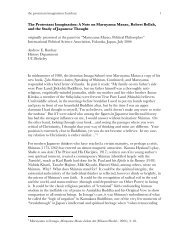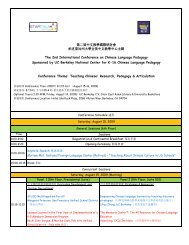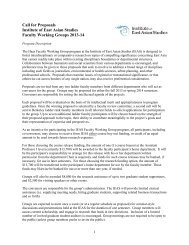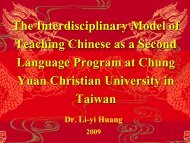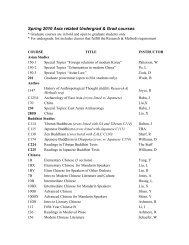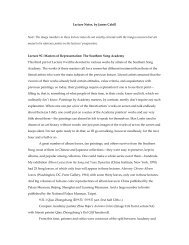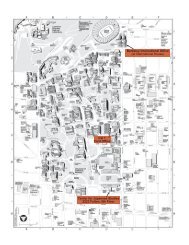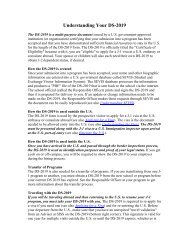Third Edition Spring 2013 - Institute of East Asian Studies, UC ...
Third Edition Spring 2013 - Institute of East Asian Studies, UC ...
Third Edition Spring 2013 - Institute of East Asian Studies, UC ...
You also want an ePaper? Increase the reach of your titles
YUMPU automatically turns print PDFs into web optimized ePapers that Google loves.
Thus, the metaphors <strong>of</strong> scientific racism and racial hierarchieswere directly shaped by Western conceptions <strong>of</strong> indigenous populations.The Laws <strong>of</strong> Expansion and the Expansion <strong>of</strong> LawsProtection is an ethically nebulous concept. Entities thatview themselves capable <strong>of</strong> bestowing protection frequently justifytheir actions as unequivocally ‘beneficial’ to the populations theyact upon. For example, Japanese colonization <strong>of</strong> Taiwan was openlydeclared by Japanese as beneficial to Taiwanese, while across theocean a few decades later, US internment <strong>of</strong> Japanese-Americansduring WWII was deemed beneficial to those interred. 17 , 18 Additionally,‘protection’ establishes an unmistakable hierarchy <strong>of</strong> power.Accordingly, ‘protection’ <strong>of</strong> Ainu under Japanese law alignedprimarily with the interests <strong>of</strong> Ainu colonizers.Political advocacy <strong>of</strong> legal protection for Ainu began in thelate 19th century, following centuries <strong>of</strong> Ainu-Japanese interaction,and beginning in the 17th century, <strong>of</strong>ficial trade relationships viaJapanese outposts in Hokkaido. Prior to the introduction <strong>of</strong> protectionlaws, the settling <strong>of</strong> Hokkaido by the Japanese governmentwas openly referred to as colonization. 19 In present-day Japan, thispast is now referred to as ‘development’ instead <strong>of</strong> colonization,implying that the occupation <strong>of</strong> Hokkaido was instead a ‘natural’extension, and a periphery settled rather than taken. Arguably,this orientation obscures the violence underpinning the process <strong>of</strong>land and resource annexation, and the corresponding exploitation<strong>of</strong> Ainu inhabitants.discusses how physical measurements, such as brain weight and skull shape, wereemployed as ‘evidence’ <strong>of</strong> racial and gender inferiority, observing that metaphor “generatesdata that conform to [the nature it constructs], and accommodates data that are inapparent contradiction to it, so that nature is seen via the metaphor and the metaphorbecomes part <strong>of</strong> the logic <strong>of</strong> science itself.” (Stepan 371)17 Siddle, Race, Resistance and the Ainu <strong>of</strong> Japan, 82.18 See: Colleen Lye, “A New Deal for <strong>Asian</strong>s,” in America’s Asia: Racial Form andAmerican Literature, 1893-1945 (Princeton, New Jersey: Princeton University Press,2005), 141-203.19 Siddle, Race, Resistance and the Ainu <strong>of</strong> Japan.Reacting to the threat <strong>of</strong> Russian encroachment, Japaneseassimilation <strong>of</strong> Ainu strengthened the Japanese claim on Hokkaido,as did the enforced annexation and control <strong>of</strong> selective land, andremoval <strong>of</strong> Ainu inhabitants. Competition between Japan and Russiato claim Hokkaido was driven by the desire to claim the wealth<strong>of</strong> natural resources, including coal, timber, and fish, and to exploitthe agricultural potential <strong>of</strong> the land. Following the Meiji Restoration,the colony <strong>of</strong> Ezochi (Ezo, or Ainu, land) was renamed Hokkaido.Settlement functioned to legitimate Japanese rule. Accordingly,a rapid movement <strong>of</strong> Japanese settlement and agriculturaldevelopment was incentivized by land grants. Though there wasan emphasis in the language <strong>of</strong> <strong>of</strong>ficial policy promoting a vision<strong>of</strong> kindness and harmony with ‘natives,’ the Japanese governmentsimultaneously declared Ainu residency as non-ownership, andpassed laws to legally uphold this belief. 20Not all inland Ainu lands were seized at first, but when resourceswere sought by Japanese, such as hunting access, the Ainuwere forced to relocate, and laws were passed to ban Ainu huntingtools and techniques. Following the introduction <strong>of</strong> hunting riflesby Japanese, deer herds approached extinction within a fewyears. 21 Similarly, bans on Ainu fishing and appropriation <strong>of</strong> fisheriesimpeded Ainu autonomy, while unrestrained Japanese consumptionled to sudden and dramatic resource depletion. Withoutaccess to their conventional foodways, Ainu began to die <strong>of</strong> starvation.22 Some attempts at amelioration were made by the Japanesegovernment, such as the granting <strong>of</strong> small plots <strong>of</strong> land for agriculturalproduction to Ainu, but ultimately, only small amounts <strong>of</strong> landwere given to few individuals. 23 Meanwhile, Ainu settlements wereincreasingly relocated to land ill-suited to agricultural productionin order to make prime land available to Japanese settlers. Ainurelocation settlements were deliberately scattered in an attemptto separate and weaken Ainu communities. Ironically, the surveyingand mapping <strong>of</strong> lands to be sold or distributed by the Japanesegovernment relied heavily on Ainu knowledge and labor; after all,20 Ibid.21 Ibid.22 Ibid., 63.23 Ibid.77 Valerie Black Ainu Indigeneity 78




